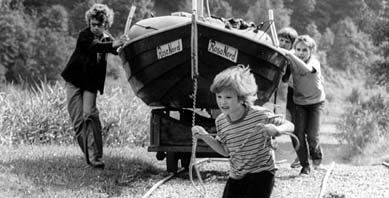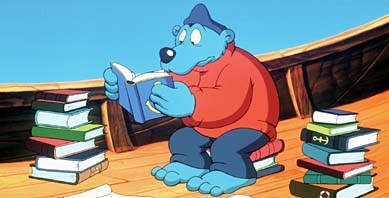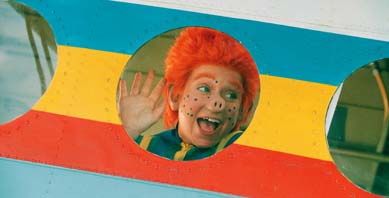Germany's New Children's Cinema - A Survey

by Katrin Hoffmann
In June 1997 Tilmann P. Gangloff in the Frankfurter Rundschau spoke of "a crisis in German children's cinema". In retrospective, this assessment correctly reflected the last two decades. But nowadays, this is certainly no longer the case. The 1980s certainly saw a number of exceptional children's films in Federal Germany like Arend Agthe's "Flußfahrt mit Huhn" (1984) and "Der Sommer des Falken" (1988) as well as certain outstanding DEFA productions from the GDR like Rolf Losansky's "Der lange Ritt zur Schule" (1981) or Helmut Dziuba's film "Sabine Kleist, 7 Jahre" (1982). The newly reunified Germany of the 1990s still saw productions like "Krücke" (1993) by Jörg Grünler, "Die Distel" (1992) by Gernot Krää or "Pauls Reise" ("Paul's Journey", 1998) by René Heisig. Nevertheless, it has to be said that in the Federal Republic of the 1980s as well as in the reunified Germany of the 1990s, these and many other good films made very little money due to spectacularly bad marketing strategies. That's why most of them were not noticed by a larger public. Furthermore, children's films in particular need a good promotion right from the very start to make sure that they are adequately offered to their target audience – it's only after that that children's films extend their theatrical run over several years in Arthouse cinemas as well as in children cinema initiatives.
Even a gem like the animation film "Das kleine Gespenst" (The Little Ghost, 1992) by Curt Linda did not rank higher than 77th place in 1993 with an audience of 265.824 visitors. The few successful family films, such as Joseph Vilsmaier's "Charlie & Louise" (1994) and "Rennschwein Rudi Rüssel" ("Rudi the Racing Pig", 1995) by Peter Timm, did rely on considerably higher production and promotion budgets and usually started off with a larger number of film copies.
Stepping Back into the Limelight

Categorizing "children's films" is still no easy task. Children's films should always be family films, so-called "family entertainment". Therefore, these productions – already at the level of screen play writing – have to take into consideration that the film has to be entertaining for adults, too. The most interesting productions incorporate a meta-level that offers a second reading for adult viewers which may not reach the children but does not disturb their reception of the film either.
In a good children's film we naturally expect the same quality of set design and direction as in productions aimed at larger target audiences. But the theatrical run of productions labelled as "children's film" is often limited to the afternoon time slot. This scheduling proved to be fatal for Bernd Sahling's "Die Blindgänger" ("The Blind Flyers", 2004) – a film that appeals to both young people and adults: despite an excellent media and press coverage "The Blind Flyers" reached an audience of barely 13,000 viewers with only 43 film copies in the first month. The previous month, however, saw "Lauras Stern" ("Laura's Star", 2004) by Piet de Rycker and Thilo Graf Rothkirch reach an audience of just over one million – backed up by a considerably higher number of film copies. Nevertheless, Sahling's film "The Blind Flyers" won the German Film Award in 2004 when the category of children's film was awarded for the fifth time. So far, the winners have been Hayo Freitag's "Käpt'n Blaubär - Der Film" ("Capt'n Blue Bear", 2000), "Der kleine Vampir" ("The Little Vampire", 2001) by Uli Edel, Ben Verbong's "Das Sams" ("The Slurb", 2002) and "Das fliegende Klassenzimmer" ("The Flying Classroom", 2003) by Tomy Wigand.

This award has given an enormous impetus to children's cinema. Due to the elevated image of the genre regional and national film funds opened up to childern's film projects although the commercial assessment is taken into account more consistently than ever before. And with great success, too, as the genre of children's film is now being ranked quite high on the list of commercially successful films: Hermine Huntgeburth's film "Bibi Blocksberg" (2002) and "Der kleine Eisbär" ("The Little Polar Bear", 2001) produced by Rothkirch reached an audience of over two million viewers each. Similarly, Caroline Link's film "Pünktchen und Anton" ("Anneluise and Anton", 1999) attained an audience of almost two million viewers over the period of four years. In October 2004, "Bibi Blocksberg und das Geheimnis der blauen Eulen" ("Bibi Blocksberg and the Secret of the Blue Owls", 2002) by Franziska Buch and "Laura's Star" placed 5th respectively 7th place in the film charts of the German Federal Film Board (Filmförderungsanstalt FFA), just behind its Hollywood rival "Shark Tale" (4th), and the German productions "7 Zwerge - Männer allein im Wald" ("Seven Dwarves", 2nd) and "Der Untergang" ("The Downfall", 1st). According to FFA statistics, Ben Verbong's "Sams in Gefahr" ("My Magical Friend Sams", 2003) was the second most successful German film in July 2004. In similar fashion to the film funds, the Foundation of New German Film (Kuratorium junger deutscher Film) started promoting the genre of children's films in 1998 alongside its regular promotion of young talents. In addition, an academy for the development of high quality children's films has been set up within the Foundation to instruct young talents how to write screen plays. Jörg Grünler's film "Der Zehnte Sommer" ("The Tenth Summer") was one of the first projects the Foundation helped to develop with a sum of DM 40.000. The film's official launch in 2003 in turn confirmed the Foundation's policy to support the idea of the film – even when "The Tenth Summer" in the end did not get the attention it would have deserved.
Kästner, Sams und Bibi – Making Use of Success Stories

The most successful German productions of the last few years relied upon popular stories and well known characters: There are the film versions of Erich-Kästner-novels as well as various "Bibi Blocksberg" films, all of them produced by Uschi Reich and Bavaria Film. Also worth mentioning here are the film versions of Paul Maar's children's book character "Sams" as well as the extremely precise animation films of Rothkirch Cartoon Film. These include "Laura's Star" as well as "Der kleine Eisbär" ("The Little Polar Bear", 2001) and "Tobias Totz und sein Löwe" ("Tobias Totz and His Lion", 1999). Other popular films are Joachim Masannek's "Die Wilden Kerle" ("Wild Soccer Bunch", 2003), its sequel in February 2005, and the animation film "Felix - Ein Hase auf Weltreise" (2005) by Giuseppe Maurizio Laganà. The trend is to make use of material that children are most likely to recognize from their (picture) books, radio plays or television programs. These adaptations, often produced with a large budget, are likely to succeed at the box office, whereas less known titles and less catchy material – like for instance Claus Strigel's very well done and lightly absurd film adaptation "Die grüne Wolke" ("The Last Man Alive", 2001) – received hardly any public attention in the last few years. One particular drawback in German children's cinema, at least when the protagonists are themselves children, are the difficult shooting conditions: the stipulations producers have to meet are extremely strict as soon as children are present on the set. Although the protection of young protagonists can only be welcomed, the constrictions do impose certain direct limitations on the creative process. For instance, since filming of child protagonists is not allowed after 10:00 PM, the shooting of real night scenes is made practically impossible in the summer – when most productions have to take place because of the children's school holidays. Furthermore, children must not work longer than four hours per day – which already includes the time to get to and from the set – as well as no more than a total of 30 days per year. In the face of these rather narrow time frames that considerably constrict continuous shooting, tribute has to be paid to the large number of new and successful children's films in Germany today.